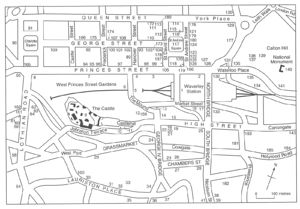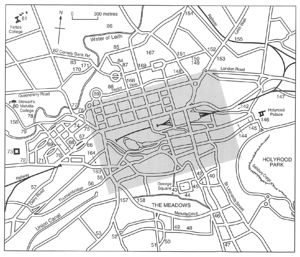Building stones in Edinburgh from the Permian and Triassic New Red Sandstone of Dumfries & Galloway and Cumbria
From: McMillan, A.A., Gillanders, R.J. and Fairhurst, J.A. 1999 Building stones of Edinburgh. Edinburgh: Edinburgh Geological Society.


The Permian red sandstone from the Dumfries area, quarried at Locharbriggs, Corncockle, Gatelawbridge and Closeburn and the Triassic red sandstone of Corsehill, became available in Edinburgh from about 1850 onwards after the eventual completion of the Caledonian Railway line.
Locharbriggs
At Locharbriggs Quarry, Dumfries, dune bedded red sandstones of the Locharbriggs Sandstone Formation have been worked for 150 years by Baird & Stevenson (Quarrymasters) Ltd. The rock is medium- to fine-grained red sandstone, very well sorted, and consists of sub- to well-rounded quartz grains, coated with iron oxide and weakly cemented by silica. Some feldspar is also present.
One of the most prominent buildings in the city centre built of stone from Locharbriggs is the brick-red Caledonian Hotel (65) (1899-1903) which has been described as 'a wonderfully blousy red sandstone intrusion into classical Edinburgh'. Some stone from Corncockle Quarry was also used. The recently cleaned, fine- to medium-grained sandstone shows good dune bedding in its polished surfaces. Eight impressive Corinthian monoliths surround the entrance to the adjacent former station of the Caledonian Railway which brought the stone to Edinburgh. There is weathering on the easternmost column and on the east side of the building high up between the two-storied dormer windows but generally the Locharbriggs stone has stood well. At ground level some plastic repair has been carried out where some of the sharp arrises were becoming eroded by constant evaporation of splash-back water from the pavement. Most of this repair work, however, was undertaken to replace mechanical damage caused by rusting railings, now replaced. Stone from Locharbriggs was also used for the Lauriston Place Fire Station (160) (1897-1901) and slightly later, together with sandstone from Closeburn, in the Edinburgh College of Art (30) (1906-10). Some 60 years later, stone from Locharbriggs Quarry was still available for the building of the Art College extension in 1972. The older buildings in the area are showing some signs of weathering with bedding picked out in the western side of the Fire Station by differential erosion.
Corncockle
Corncockle Quarry, north of Lochmaben, also has a long history of working until the mid 1950s. It was re-opened in 1986 and Onyx Contractors work it on an intermittent basis, supplying stone for specific projects. The Permian Corncockle Sandstone Formation consists of thick beds of aeolian, fine to medium-grained, well-sorted, red sandstone, composed of quartz with minor amounts of feldspar.
Corncockle stone was much used in Edinburgh between c.1880 to c.1900, particularly for dressings on Edinburgh Board schools.' An example is the Scotch Whisky Heritage Centre (formerly Castlehill School) (10) (1888) at the top of the Royal Mile, where greyish, coarse, squared-rubble Hailes is contrasted with deep red, diagonally droved, Corncockle dressings. The detail is still sharp at lower levels but there is scaling in the dressings and detail in the upper part of the building, especially on the north side. At the base of the Meadows Sundial (158) the Corncockle sample shows no appreciable weathering. Other examples include:
Leith Academy Lochend Annex (1885-87), Lochend Road.
Royal Bank of Scotland (39) (1902), Nicolson Street
Milton House School (144) (1886), Canongate. With 'grey' Hailes.
Gatelawbridge
Permian aeolian dune-bedded sandstones of the Thornhill Sandstone Formation have been worked at Gatelawbridge: and Closeburn quarries near Thornhill.
Gatelawbridge has been worked from the 17th century onwards and was at one time leased to Robert Paterson (1717-1801), alias 'Old Mortality' (of Sir Walter Scott's novel). Although much used in Glasgow, Gatelawbridge stone is only known to have contributed to one building in Edinburgh situated on the north side of Rose Street (187), immediately behind Jenner's store. This was designed as workshops for Charles Jenner, the first part built in 1890 and the second, including the Abbotsford Bar (187) in 1902. This bright red sandstone from near Thornhill clearly shows dune cross-bedding at ground level on the polished west and south sides of the building. On the west and north sides the building is rock-faced, with polished quoins. Above street level on the west end, the stone is lightly stugged with smoothed margins. There is some efflorescence above the windows at the east end, perhaps a consequence of cleaning which has brought salts out of the stone. Gatelawbridge stone is scaling on both of the Meadows Pillars (158). Newton Quarry at Gatelawbridge was re-opened in 1986 by Scottish Natural Stones Ltd. It has supplied stone for Saltire Court (63), Castle Terrace (see also Stainton) and the Edinburgh Solicitors Property Centre (174) 85 George Street.
Closeburn
A good example of the use of the deep red sandstone (Thornhill Sandstone Formation) from the former Closeburn Quarry, south of Thornhill, is the King's Theatre (157), Tollcross, built in 1904 and repaired with indents of Corsehill in the 1980s. The stone was also used for the tower of Candlish Church (1915), Merchiston, along with rubble work from Hailes.
Corsehill
Triassic red sandstone (St Bees Sandstone) was worked at Corsehill Quarry, Annan from the 1880s until the mid 1950s. The quarry was reopened in 1981 and is currently operated by Onyx Contractors. In contrast to the other red sandstones from Dumfries & Galloway, those of Corsehill are of water-lain origin. Beds are generally thinner, but are laterally continuous. Internal cross-bedding within some beds is discernible but is much smaller scale and less prominent than in the desert sandstones. Being fine-grained and capable of carrying a sharp arris, the stone has traditionally been used for all kinds of inside and ornamental work and carving, and is noted for its use, not only as a construction stone, but also for monuments, panels, quoins and plinths.
Corsehill stone is a warm red, fine-grained, slightly micaceous sandstone. It has been used at No. 70 Princes Street (98) (1886) although not at street level. At the National Portrait Gallery (114) (1885-90) in Queen Street, where stone from the Dumfries area was first used on a large scale in Edinburgh,' it is not possible to distinguish Corsehill sandstone from the Cumbrian equivalent, formerly worked at Moat, near Carlisle, which was used with it. Here, damage to the stone was so severe that it was necessary to remove the parapet and pinnacles of this Doge's Palace' in 1980. However, it is likely that it is the Moat stone that weathered poorly as Corsehill stone from the re-opened quarry has excellent resistance to weathering. Restoration of the detail will proceed using matching Dumfries stone removed from an old former Caledonian Railway bridge in Leith and from the present Corsehill quarry. The disabled access in Queen Street appears to be of sandstone from Locharbriggs. Examples of both Corsehill and Moat stone at the Meadows Pillars (158) are weathered and much of the original detail has disappeared. However, the Corsehill sample in the nearby Meadows Sundial is weathering well. Other red sandstones from the Dumfries area show slightly better weathering properties. The use of Corsehill dressings with 'pink' and 'grey' Hailes is well displayed in Roseburn Primary School (1893), Roseburn Street (Plate 5). Further uses of Corsehill can be seen at St James Episcopal Church (1885), Inverleith Row, the Royal Hospital for Sick Children (49) (1892), Sciennes Road, and No. 1 Cluny Gardens (with 'pink' Hailes).
Lazonby
Dune-bedded, pink to red-brown medium-grained sandstone of the Penrith Sandstone Formation of Permian age is quarried near Lazonby, north of Penrith. Currently marketed as `Stoneraise Red' by Realstone Ltd. and as `Plumpton Red Lazonby' by Cumbria Stone Quarries Ltd., the stone has been used in Edinburgh, for example in the interior access to the new crypt or undercroft of the High Kirk of St Giles (18) (1984).
Moat
Bright red, water-lain sandstones of the St Bees Sandstone Formation (Sherwood Sandstone Group) of early Triassic age were worked intermittently at Moat Quarry, north of Longtown. This quarry formerly supplied stone for the National Portrait Gallery (114) (1885-90) (see also Corsehill) and for Couper Street School (1889-90).
| At all times follow: The Scottish Access Codeand Code of conduct for geological field work |